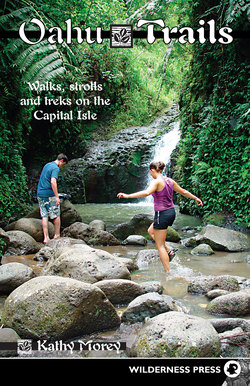Читать книгу Oahu Trails - Kathy Morey - Страница 16
На сайте Литреса книга снята с продажи.
ОглавлениеWeather
The short of it
Oahu is:
Rainiest on its windward side, which boasts rainforests. Ahupuaa o Kahana State Park is in a rainforest.
Driest and hottest on the south and west sides. These areas lie in the rain shadows of the island’s mountains. Waikiki is one such hot, dry area, as is the rest of Honolulu. Honolulu lies in the rain shadow of the Koolau Range, which defines northeast Oahu. The hot, dry southwest coastal plains, home to famous surfing areas like Makaha, lie in the rain shadow of the Waianae Range, which defines southwest Oahu. Between the ranges lies the Schofield Plateau, shielded by the Koolaus and also warm and dry.
Rainier in the mountains, particularly the Koolaus. The Koolaus, though barely over 3000 feet high at most, harbor rainforests not only on their windward slopes but on the upper reaches of their leeward slopes. The Waianaes are largely shielded by the Koolaus, however; only the highest points, like Mt. Kaala, have rainforests and swamps.
The dry Honolulu area, particularly Waikiki, has the greatest concentration of visitors, hotels, and resorts. The figure on the next page summarizes the situation.
The long of it
Hawaii’s coastal weather is temperate to a degree that puts the so-called “temperate” zones of the world to shame. The humidity is moderate, too: 50% to 60%, not the sweltering horror of some other tropical lands. It is warmer in the summer and cooler in the winter, but the “extremes” are only a few degrees apart—nothing like those on the mainland.
Hawaii’s mild climate is determined largely by its tropical location and also by the northeast trade winds that sweep across it. The northeast trade winds—so-called because sea captains took advantage of them on their trade routes—are dependable, steady winds that blow from the northeast across the thousands of miles of open sea that separate the Hawaiian Islands from the continents. They are responsible for keeping the temperature and the humidity moderate. Since they are the prevailing winds in this area, the side of the island that faces them is called the “windward” side. The opposite side of the island is the opposite of windward; in nautical terms, “leeward.”
Sometimes the trade winds fail and are replaced by “kona” winds coming from the south. “Kona” means “leeward,” because it’s the leeward side of the island that more or less faces these occasional winds. Kona winds bring hot, sticky air. Fortunately, they are rare in summer, when they would be really unpleasant, and occur mostly in winter, when the lower overall temperatures moderate their effect. Kona storms are subtropical low-pressure systems that occur in winter, move in from the south, and can cause serious damage. There is apparently no pattern to them; in some years, they do not occur at all, but in others they occur every few weeks.
Oahu Weather Map
On Oahu, average temperatures in Honolulu (leeward) range from highs of 80–85°F to lows of 70–75°F. In Kaneohe (windward), temperatures range from highs of 80–82°F to lows of 62–70°F. The “cooler” ones are winter temperatures, the warmer ones summer. It’s rainier from November through March than it is the rest of the year. Expect cooler temperatures, more wind, and considerably more rain if you are in a mountainous region.
